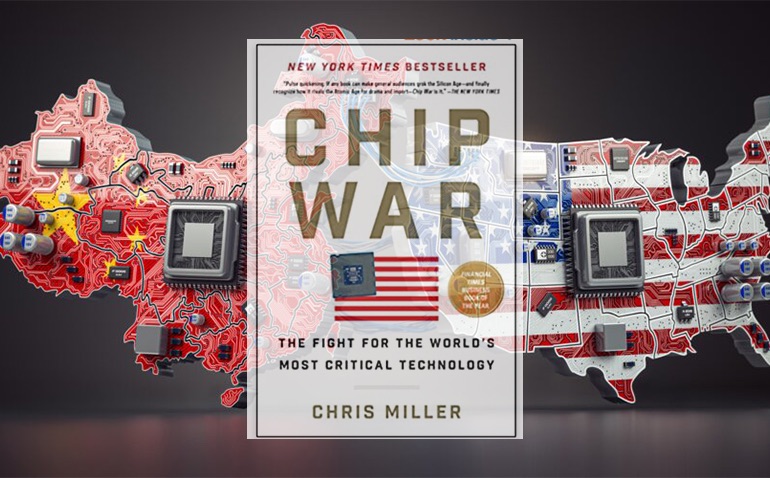
BPF Book Review of “Chip War” by Chris Miller
‘Big data’ is the world we live in now. Powerful companies like Amazon, Google, Microsoft and Facebook, are the current masters of the ‘big data’ universe. With their hyper-scale software platforms these behemoths dominate today’s economy. But software fortunes that bloom into the trillions need cutting edge hardware to splice, dice and process the tsunamis of data that spew in, through and out of our iPhones daily. The fount of that cutting edge hardware is the engineering, physics, chemistry and lithography expertise housed in the clean rooms of multi-billion dollar semiconductor fabrication plants (fabs). The top tier fabs are now strategic assets at the highest levels of global economics and politics.
In Chip War – The Fight for the World’s Most Critical Technology, author Chris Miller masterfully recounts the epic journey of the transistor from rudimentary invention in the early 50s to today’s system-on-a-chip with billions of transistors that are, as the book’s subtitle suggests “the world’s most critical technology.” Chip War is a technology history book that also provides keen insight into the rising economic confrontation between America and China.
It is an extraordinary tale with many twists and turns and a cast of eclectic characters armed primarily with slide rules and pocket protectors. Included are inventors, entrepreneurs, outside-the-box thinkers, refugees fleeing communism – Morris Chang from Shanghai in 1948 and Andy Grove from Hungary in 1956, marketers, purveyors of capital and lastly, a marketplace hungry for more speed, cheaper prices, smaller footprints and new products.
The journey began with the invention of the transistor for which William Shockley, John Bardeen and Walter Brattain received the Nobel Prize in 1956. Shockley had rightly concluded that a semiconducting material like silicon would be an excellent substrate for a transistor. In 1958, Jack Kilby invented the integrated circuit – multiple transistors on one chip, for which he also received the Nobel Prize. The first market for the integrated circuit was the chance to replace expensive and clunky vacuum tubes that served as switches in the hulking, room-sized computers of the 1950s and early 60s. Over time, chips would change everything about computing – its price, its performance, its size and its ubiquity.
In 1965, Gordon Moore, co-founder of Intel, made his famous prediction of an annual doubling of transistors per chip for the decade ahead. In 1975, he revised it to a doubling every two years. Moore’s insight that few others appreciated was that as transistors shrunk in size they would use less power, be more reliable and fall in price.
Moore’s Law was prescient and it set the trajectory of the semiconductor industry for half a century. Such enormous productivity gains year after year, decade after decade have never been experienced before or after, and these gains created unique business challenges for the fledgling industry. If capacity was growing exponentially and prices fell in pace, markets would need to grow rapidly to avoid collapses in revenue for the producers. New markets had to be identified to absorb the gusher of capacity that came on stream as Moore’s Law played out. America’s military industrial complex was an early and important customer, but new consumer mass markets were still vital to delivering economies of scale. It turns out, shrinking transistors are very expensive requiring ever more investments in sophisticated and expensive tools and technology.
By the 1980s, Moore’s Law was manifesting major disruption as mainframes gave way to minicomputers which gave way to PCs. Semiconductors became a virtuous cycle where falling prices opened vast new markets for chips such as calculators, appliances, gadgets, cameras, watches, video games, dashboards of automobiles and cellphones. The critical mass of consumer markets, sales and production paid off for the American military as well. From page 159, “The Soviet Union’s rockets were as powerful as ever. It had the world’s largest nuclear arsenal. But its semiconductor production couldn’t keep up, its computer industry fell behind, its communications and surveillance technologies lagged, and the military consequences were disastrous.” In short, America’s global lead in semiconductors played a critical role in concluding the Cold War with a whimper and not a bang.
But the Cold War ended 35 years ago, and semiconductor fabs and supply chains have changed dramatically since then. We can thank Morris Chang’s personal pioneering journey for that. Chang fled Shanghai for Hong Kong at age 14, then to the U.S. and MIT, then on to Texas Instruments for 25 years where he became their expert on semiconductor production and processes. In 1985, Chang was recruited by Taiwan’s government to oversee Taiwan’s semiconductor industry. Chang initiated a new foundry business model manufacturing chips for fabless design companies around the world. An extraordinary success, Taiwan Semiconductor (TSMC) is now the world’s leading foundry with 9 fabs across Taiwan producing 40% of the world’s chips and 90% of the world’s high-end chips.
TSMC is a unique global resource, but its location, only 100 miles from China, is cause for grave concern in the world of military planning.
Miller devotes the final chapters of Chip War to exploring the rising ‘great power’ competition between the U.S. and China and the critical role that the top tier semiconductor fabs now play in global trade and geopolitics.
Chip War is an important history book, but its thesis is really about the future. If you are a history buff, a technology follower, an investor or just someone trying to make sense of the craziness we live in, you should read it. It is a dangerous world and these are scary times.
Sign up for BPF’s latest news here.
